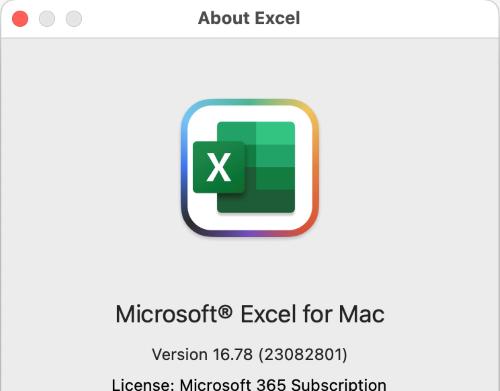Excel for Mac: Introduction – A New Series
8 December 2023
This is the first in our new blog series, all about Microsoft Excel for Mac. In each post, we’ll cover a different topic to help you understand how Excel for Mac is different to Excel for Windows. But hey, let’s get introductions out of the way first!

Microsoft describes their applications on Mac as “uniquely Office and optimized for Mac”. This is their way of saying that the apps are not exactly the same on Mac as they are on Windows, but it’s intentional, because Mac is different from Windows. In this series, we’ll dive into details about important differences, and we’ll show how you can use Excel successfully even with those differences. There are some features that just don’t exist in Excel for Mac, and we’ll help with workarounds or other solutions where possible.
A bit of history
Did you know that the first version of Excel was released for Macintosh computers? Not only that, but it was available for Macintosh two years before it became available for Windows. That’s right: in 1985, version 1.0 of Excel was released, but it was only compatible with Macintosh at the time. When released for Windows two years later, it was called version 2.0 to stay in step with the version on Macintosh.
As Windows became the dominant operating system in use throughout the world, making Excel great on Windows took priority, and understandably so. At some point, Microsoft even split off the development teams for their Mac apps into a separate business unit, call “Mac BU”, which later became known as APEX (the Apple Productivity Experience Group).
The goal of Mac BU was to make experiences in the apps that would meet the expectations of Mac users. It’s understandable that there should be differences, given that the operating systems are quite different. For example, Mac’s “light-dismiss” behavior for dialog boxes led to differences in Excel’s Filter dialog between Mac and Windows. The key difference being that filter selections are applied immediately on Mac. Conversely, they aren’t applied until you click OK, or press ENTER on Windows. The Filter dialog on Mac now has an option for ‘auto apply’ or not.
It became typical for innovations to be developed and added to Excel for Windows, and then “ported” to Excel for Mac. Porting is a developer’s way of copying code from one codebase to another, but it involves some work to adapt it so that code written to run on Windows will work on the Mac.
For these two reasons – having a separate business unit and the need to port code from Windows to Mac – the number of differences, including feature gaps, grew over the years. Some Mac-specific capabilities were added by the Mac BU / APEX team, and some features were either not ported completely or not ported at all.
Coming back together
Eventually, there were enough differences between the apps on Mac versus Windows that many customers weren’t satisfied. Mac users weren’t getting the same power and capability, and they let Microsoft know about it. Microsoft could have decided to port more features to Mac. However, one of the big innovations – coauthoring – would be very complex to port, particularly for Excel.
Coauthoring was a must-have for the Mac apps. Therefore, in 2017, the decision was made to bring the codebases and business units back together. This was the best way to enable coauthoring in Excel for Mac. For the next year, the previously separate Excel teams came together and embarked on a momentous project to build the apps for both Windows and Mac from a single codebase. In simple terms, this meant having only a single engine, or core, for Excel, with would work on both operating systems. The user interface would be different, but not the engine.

In January 2018, version 16.x was released. This was built from the shared codebase, and Office for Mac and Windows have been running on shared code ever since. There are still differences, but the number of features missing on Mac has been reduced dramatically. Some are “earned” differences, meaning that they’re intentional for the experience on each operating system, and not due to the organisational structure of Microsoft. Other differences are due to the underlying capabilities of each operating system.
Please come back for future posts in this series, as we cover much more about Excel for Mac.

